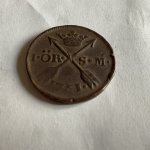lab rat
Hero Member
- May 21, 2003
- 947
- 141
- Detector(s) used
- Minelab Sovereign
- Primary Interest:
- Beach & Shallow Water Hunting
I went out yesterday for the first time in a week, expecting not to find anything.? Temperatures are cooling down, and not so many people going to the beach these days.? So I figured I'd keep my expectations low.? But 15 minutes into my hunt I found this beauty-- 32 natural diamonds in 14k gold!
Upvote
0


 ... Just kid'n
... Just kid'n


